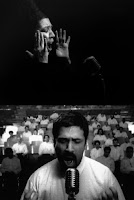Throughout history women have been making and more importantly defying the standards and norms of society. One of the few ways we are able to see these changes being made in history was and is through art. But it is in this modern era in particular that we can truly take into appreciation all the contributions that women of the past and women of the present day have made (or are making) changes by sculpting their way to create an even greater future. There are many artists that can be looked up to today when talking about the modern contemporary artist. They are renowned not only for their talented works but for speaking up and voicing their stances strongly on topics such as race, politics, and gender equality.
 |
| The Dinner Party (1974-1979) |
I had the privilege of visiting the Elizabeth A. Sackler Center for Feminist Art which is home to Judy Chicago’s piece The Dinner Party (1974-79) and is currently featuring Radical Women: Latin American Art exhibit where my perspective on the importance of seeing pieces of art in real life changed. To start off The Dinner Party blew my mind and actually seeing the amount of detail that went into it had me speechless. Every feature of the piece had a significance that really put women from all different eras, art backgrounds, styles, and causes on such an honorable pedestal, finally getting the recognition they deserve. The installation features 39 amazing women, either mystical or historical, from all over such as Judith, Artemisia Gentileschi, Sojourner Truth, Susan B. Anthony and many more, each decorated according to the person.The piece sits on a porcelain floor which also features 999 names of women called the Heritage Floor. On each corner of the triangular table area is an M, which stands for Millennium, that prophesies a better future in the Millennium that gave women the same reality as the Dinner Party. Chicago portrayed her piece in order to honor the women artists of the past as stated by Chadwick, “The self-conscious investigation of female subjectivity through images of the body was one aspect of the desire to celebrate female knowledge and experience” (358). Chicago’s piece left me in awe and made me realize how important it is to continue fulfilling the prophecy by continuing to support women who have given so much to alter the future.
As I continued to rome around I stumbled upon the works of Lourdes Grobet titled Hora Y Media (1975) at the Radical Women: Latin American Art exhibit. She was born in 1940, Mexico. She is a photographer who sought to raise awareness of the under representation of women artists and wanted to bring the conversation of it into the public sphere. In her photograph is a performance piece which essentially features a series of transformations captured within the three black-and-white frames. Grobet displays herself walking or emerging from the metallic sheet. She does this to evoke the symbolism of childbirth and metaphorically manipulates the unseen women in artistry and their lack of representation in the field.
Racism: Kara Walker
Another contemporary artist that speaks up about urgent issues is Kara Walker. She is an African American artist who was on born in 1969. In her works of art she uses her voice to call into attention gender roles, stereotypes, violence and more specifically racism. One of her most renowned pieces African’t (1996) is about 66 feet long and features black cut-out silhouettes of figures and scenes that portray the brutality that countless African Americans endure in modern day society. Her works call into question about how dominance continues to subjugate everyone within society and that through her work she raises awareness about these issues such as racism in a brutal yet humorist way.
 |
| Turbulent (1988) |
Gender Roles: Shirin Neshat
An artist who calls out the gender roles of her society is Shirin Neshat. She was born in 1957, Iran. Among many of her pieces in her work is Turbulent (1988). It an experience that takes you literally between two performance of one man singer on one wall and one woman singer on another. Both of their performances take place in an auditorium, the man turns his back on an audience of solely men but the woman is faced forward to an empty room. After the man performs his love song passionately, the all-male audience applauses. The woman’s performance then begins, only she is not singing actual words and yet the voice and passion in her speech is unexplainable. Neshat in many ways gives the woman a voice of her own, one that does not need the approval of an audience to keep her from being heard.
 |
| Over My Dead Body (1988) |
Political Affairs: Mona Hatoum
In the works of Mona Hatoum, she displays her views on the political affairs and ongoing conflicts in the MiddleEast. She was born in 1952, Lebanon. In her piece, Over My Dead Body (1988) she captures one side of her face as she glares at the not-so-menacing toy soldier standing on the bridge of her nose. She uses the object of a mini soldier to symbolize that in her eyes the reasoning behind war is minuscule in the grand scheme of things. In many ways she manipulates the sizes of both her and the soldier to display that even soldiers are vulnerable. Hatoum also is displayed to metaphorically tell the story of her own people, who remained strong and kept their staring stance in the face of injustice.
 |
| Image of the Elizabeth A. Sackler Center |
Works Cited:
-Chadwick, Whitney. Women, Art, and Society. Thames & Hudson, 2007.
Links Cited:


No comments:
Post a Comment